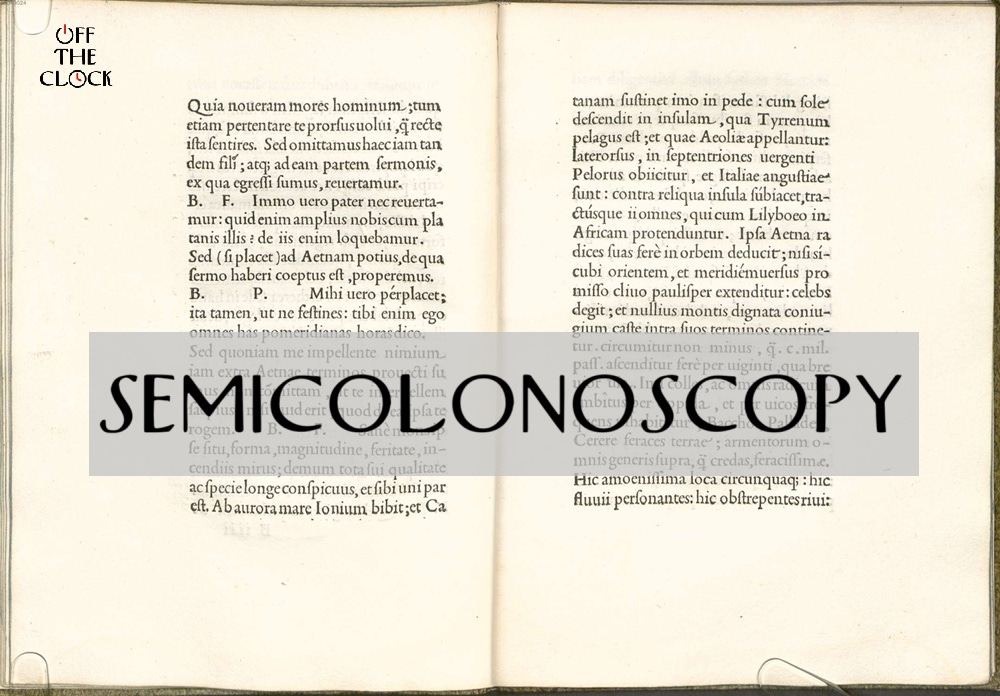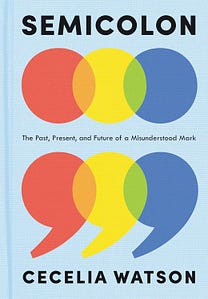👔 Coaching | 🎙️Podcast | ⏱️ Stopwatch | ⏰Off The Clock | & Guild | 📚 BooksHappy Saturday! It’s time for the hurdy-gurdy for the wordy nerdy. We’re Off the Clock. As always, the footnotes work best in the app or on the web. Normally, this is bonus content just for paid subscribers, but this week, it’s open to you. If you enjoy this and would like to get it regularly, I have an exclusive discount for you: Welcome to “Off the Clock,” a little something that lands somewhere between Timeless & Timely. I send out this fun look at language and words every other Saturday as bonus content. If someone sent this to you, please consider subscribing.
The semicolon has a long and contentious history; of late, it seems to be entering endangered species territory. Writers of all types have varied opinions on the semicolon: Edward Abbey called it the “most obscene of all punctuation marks.” Kurt Vonnegut gave this advice to writers, opting to use an ellipsis for syntax while doing so: “Do not use semicolons. . . All they do is show you’ve been to college.” (Wouldn’t it have been deliciously ironic if he had used a semicolon to separate those independent clauses?) Abraham Lincoln was more of an admirer, using it appropriately in his praise: “I have a great respect for the semi-colon; it’s a useful little chap.” However you feel about semicolons (you have taken the time to consider them, haven’t you?), they do have a purpose and some guidelines. More on that below.
The Semicolon Origin StoryIn the world of punctuation, the semicolon is a relative newcomer. The Venetian printer, humanist, and publisher Aldus Pius Manutius¹ introduced the semicolon in 1494, signifying a pause somewhere between that of a comma and a colon. The first Latin text he published was De Aetna, about climbing volcanic Mount Etna in Italy.² You can see four examples of the new punctuation mark in this excerpt: Because he ran the Aldine Press, Manutius had some influence over how punctuation was read and accepted. Other printing houses in Europe took note and began adapting the semicolon in their work; variations proliferated based on the fonts they chose.³ Clear Origin, Uncertain FutureThe rise in popularity of the semicolon is undisputed: a search via the Google Books Ngram, which includes novels, nonfiction, and even scientific literature, shows that semicolon use in English rose by 388% between 1800 and 2006. It then fell by 45% over the next 11 years. And according to a recent survey by Babbel, semicolon usage in British English books has fallen by nearly 50% in the past two decades.⁴ The survey — issued as an interactive quiz — also produced these results:
However, we shouldn’t confuse a survey with empirical data. According to Ngram again, if we look at the use of semicolons in publications, beginning 2017 it started a gradual recovery, with a 27% rise by 2022. Perhaps there’s still hope? Semicolon RulesThe most common way to use semicolons is to link two independent clauses that are part of the same thought. For example, “Tonight, I’m going out for ice cream; my favorite flavor is Rocky Road.” A handy use of semicolons is within a list of terms that already include commas. “Some of my favorite cities are Boston, Massachusetts; Sydney, Australia; and London, England.” Avoid using a capital letter immediately after a semicolon unless the word is a proper noun, and don’t use a conjunction (“and,” “or,” “but,” etc.) either. Except in the case of a list as above. Finally, if you’re in a particularly jaunty mood, you can use a semicolon if you’re building a punctuation-based emoji; it serves as the eyes for a wink emoji. ;) One Final ThingIn Semicolon: The Past, Present, and Future of a Misunderstood Mark, Cecelia Watson charts the rise and fall of this infamous punctuation mark, which for years was the trendiest one in the world of letters. But in the nineteenth century, as grammar books became all the rage, the rules of how we use language became both stricter and more confusing, with the semicolon a prime victim. In this fun biography, Watson writes a guide to grammar that explains why we don’t need guides at all, and refocuses our attention on the deepest, most primary value of language: true communication. Where do you come down on semicolon usage? There’s so much to learn,
1 Aldus Manutius: Italics, the Semicolon, and Pocket Books, UT Blog, November 26, 2015 2 Mount Etna experienced a major eruption just this week - Sicily’s Mount Etna erupts with columns of smoke and ash AP News, June 2, 2025 3 The Birth of the Semicolon, Cecelia Watson, The Paris Review, August 1, 2019 4 Babbel survey, May 20, 2025 If you upgrade your subscription, you’ll have access to our full archives, plus additional content exclusive to our Ampersand Guild. Because you’re already a subscriber, please accept this discount in appreciation for believing in Timeless values:👔 Coaching | 🎙️Podcast | ⏱️ Stopwatch | ⏰Off The Clock | & Guild | 💡Timeless Reflections | 📚 Books |
Semicolonoscopy
Subscribe to:
Post Comments (Atom)
Lightnin' Strikes
Spotify: rb.gy/sqfyaf YouTube: rb.gy/2xe2yn 1 We knew the record, we knew the name, but we couldn't pick Lou Christie out of a lin...
-
Excited to launch our first large format escape room for 4-10 players.͏ ͏ ͏ ͏ ͏ ͏ ͏ ͏ ͏ ͏ ͏ ͏ ͏ ͏ ͏ ͏ ͏ ͏ ͏ ͏ ͏ ͏ ͏ ͏...
-
What is your brand's strategy for expanding your loyal base, even in a landscape where consumers face economic pressures? ͏ ͏ ...







No comments:
Post a Comment